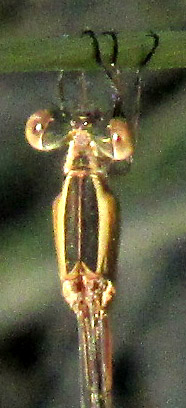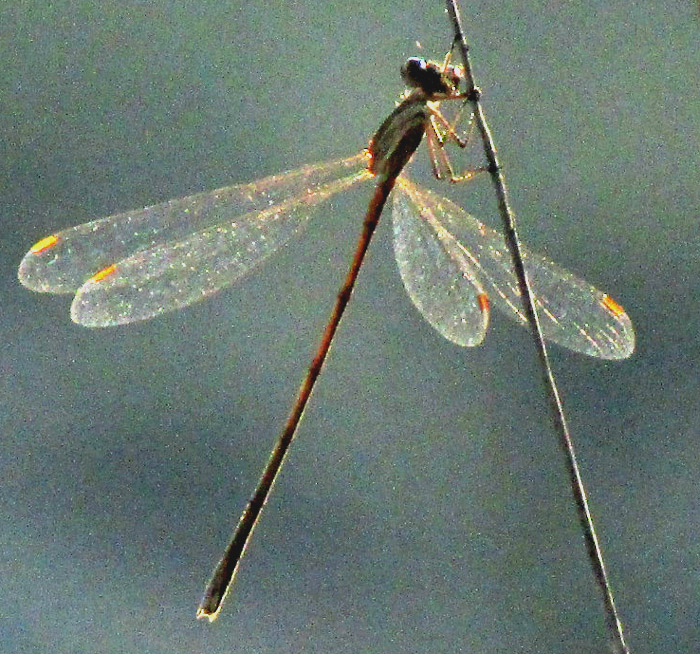Excerpts from Jim Conrad's
Naturalist Newsletter
Entry dated November 9, 2023, from notes taken near Cascadas de La Piedad waterfall 3kms NW of the community of San Pablo, municipality of Almeaco de Bonfil; oak forest atop bedrock of thick layers of compacted volcanic ash, or tuff; N20.1024°, W100.0019°, elevation 2360 meters (7750ft); extreme southern Querétaro state, MÉXICO
PLATEAU SPREADWING
 On a chilly morning in a semi-open, grassy spot in the hill's oak forest, the damselfly at the right was warming, basking in dim sunlight, its wings folded over the abdomen. The nearest standing water was over half a kilometer away.
On a chilly morning in a semi-open, grassy spot in the hill's oak forest, the damselfly at the right was warming, basking in dim sunlight, its wings folded over the abdomen. The nearest standing water was over half a kilometer away.

Seen from above, this species' combination of well defined blackish and tan markings gave it an attractively composed appearance. Black stripes running lengthwise atop the thorax were separated by a thin, tan line, and the black stripes were streamlined mirrored images of one another. This species lacked the bulbous, often blue abdomen tip often observed on the commonly occurring forktails, dancers and wedgetails.
Being unable to see wing features, in the end by browsing many pictures of dameselflies, suborder Zygoptera, occurring in highland central Mexico, it was possible to see that this was a member of the Spreadwing Family, the Lestidae. Spreadwings form a fairly small but worldwide occurring family. The above-noted features of color patterns and non-bolbous abdomen tip helped little with the family's identification. To determine that technically, the main feature to notice would have been that the wings are noticeably stalked at their bases -- something not apparent in the photos, at least if you're not sure what a stalked wing base looks like.
With help from the GBIF's occurrences maps, it appeared that only two species of the Spreadwing Family have been documented in our part of highland, central Mexico, and only one of those species exhibits the neat blackish and tan abdomen pattern seen on our damselfly. That's LESTES ALACER, in English usually known as the Plateau Spreadwing, though mostly it's a Mexican and Central American species, occurring south to Costa Rica. In the US it's found in the southwestern states. In Spanish-speaking countries its book-name usually is given as caballito crucifijo vivaz, meaning "lively crucifix little horse."
In this species, males and females are fairly similar in color. Older Plateau Spreadwings are likely to display some blue colors, and both sexes as they grow older develop blue eyes.
In the 2009 online edition of Dennis Paulson's Dragonflies and Damselflies of the West, I read that during the breeding season the species appears where you'd expect them, around bodies of water, though immature individuals are commonly seen in open woodland. "Mature adults roost, at times communally, in woody vegetation as much as a half mile from water," Paulson writes, so our damselfly in a grassy spot on a hillside fits in perfectly with that.
About an hour later, atop this hill, this basking damselfly turns up:

I'm guessing that the orange color of the narrow cells on the other wings, the pterostigmata, is a feature of intense refracted sunlight. Pictures of the species show very dark pterostigmata. In this photo, probably the wings' narrowed attachment points constitute the "stalks" peculiar to the species.